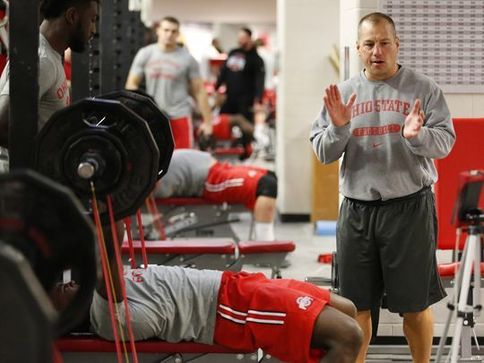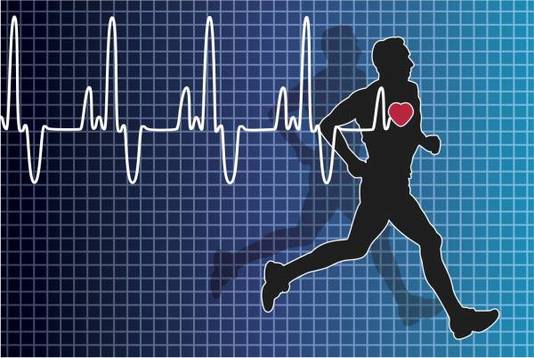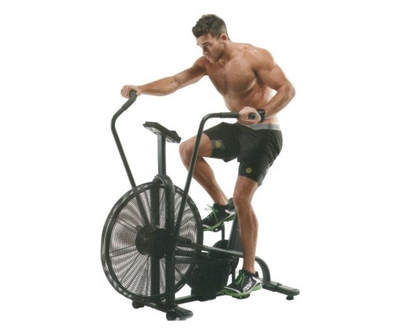|
In-season training is one of the most misunderstood aspects of athlete development. Usually there are two sides of the coin when it comes to the mishandling of how to go about continuing progress during the season. The first group of athletes and coaches simply stop training all together or are afraid to continue any type of intense training. The other group of athletes and coaches never take their foot off the gas and end up wearing themselves down, which ultimately can stunt development and progress, hurt in-game performance or even lead to injury. Proper in-season training can go a long way in furthering development that was achieved during the off-season and preserving gains made over the course of the prior six months of training. It can also help prevent injuries and improve on-field performance! When it comes to in-season training you can vastly improve the effectiveness of your programming by understanding submaximal maintenance training and flexibility with your programming, the use of concentric only exercises and using high repetitions to promote much needed recovery!
Submaximal Training and Programming Flexibility Before you begin to understand submaximal training you must first grasp the basic fundamentals of programming flexibility. Essentially, you need to have a good feel for your body and be mindful of your in-season schedule in order to adapt your program to fit your needs. For example, you may find that weather may change your game schedule during a baseball season. You must have options of varying intensities in your programming so that you can properly adjust. If you are feeling good and have an easier week of games (for any reason), you can increase the intensity of your training so that you can still make some gains and further your development. Remember, just because you are in-season does not mean you cannot further improve on attributes you gained in the off-season. With that being said, here is a quick breakdown of a method you can use to approach your loads and intensities while you are aiming to maintain, and then how you can have some flexibility in light of opportunities to up the intensity to off-season levels. I normally keep my athletes in the 70-90/95% range of their one rep max (1RM), while they are in-season. Essentially, the only time they will work towards 90/95% of their off-season 1RM is if they are only performing one-repetition sets. I feel that the 70-85% range coupled with anywhere from 2-5 repetitions is a perfect place to maintain (and even gain) strength. Once you have this is mind it is easy to see how you can be flexible in adjusting your volume and load percentages. For example, let’s take a high school baseball player who is performing two “in-season,” training day’s per-week. This athlete’s primary lower body movement is the squat, and he maxed out at 265 pounds at the end of the off-season. Let’s create a sample situation where the general program called for three repetition sets of 80% of his 1RM, but he had an easy week due to miscellaneous cancellations and scheduling complications. An adjustment to that set program would look as follows:
You can see how easy it is to adjust your intensity to take advantage of lighter weeks you may get throughout the season! Take advantage of these opportunities and adjust! Making The Most of a Prowler Sled (Concentric only exercises) I will keep this short and sweet (I promise I will try). Muscle fibers predominantly tear during eccentric portions of a range of motion. That is, the lowering of the weight where you are controlling a load or resistance is what promotes muscle fiber tears and hypertrophy. With that in mind, concentric (part of the range of motion where you are moving into extension like the pressing in a bench press or upward movement in a squat) only movements are a great way to preserve strength, but limit eccentric stresses that can cause soreness. This is key when we are in the thick of a season and we do not want to place extra stresses on our muscles. In addition, concentric only movements help us maintain much of the strength we built in the off-season. In light of this, the prowler sled is your best friend. Almost all activities done with a sled do not incorporate an eccentric load on the body. Sled pushes work your legs, but only through extension, sled rows do the same and just about any other variation can be thought of in order to preserve strength and limit muscular soreness. Using High Repetitions to Promote Recovery Lastly, I will generally make one of my suggested two-day in-season training days repetition based. Higher repetition sets at lower intensities (think of a 15 rep set with a weight you could do for 30 reps) are great to promote blood flow and recovery for an in-season athlete who may very well need this. A great way to treat recovery based repetition lifts is to perform them in a 65-75% intensity (window for aerobic recovery). In addition you can also treat the higher repetition based lifts with the same mentality as your heavier day. IT IS OK to push it just a bit if you are feeling great and have a lighter schedule that week. Go ahead and use these tools to ensure that your in-season training is effective and even result yielding as tool to send you into the next off-season with a head start on your competition!
1 Comment
How a Coordinated Relationship Between Your PT and Strength Coach Can Benefit Your Training2/23/2018 Last week my colleague Dr. Anthony Falco discussed how you could see a physical therapist without having to see a doctor first. Doing so can save you a significant amount of money in your process to heal your ailments. With that being said, I want to take the time this week to touch on the importance of a strong symbiotic relationship between your physical therapist and strength trainer. A strong relationship between your physical therapist and strength trainer can not only help limit the severity of a training related injury, but can also lessen the length of time for recovery and also help correct injuries or performance inhibited by movement dysfunction.
Limiting The Severity of an Injury One of the most common issues I have seen in the strength and conditioning field is related to lingering injuries that are never properly addressed. One of the main benefits I have seen come from sharing clients with my affiliates at Performance Physical Therapy is limiting not only the severity of an injury, but also being more efficient in recovery time. In most cases, a strength coach could further aggravate a healing ailment because they are not sure of what’s causing it. For example, a rotational athlete (such as a baseball player) could be dealing with a hip injury being caused by a misalignment of the pelvis that often comes from rotational movements such as throwing and hitting. If this athlete is either not seeing a physical therapist or that therapist isn’t in contact with their strength coach a significant furthering of that injury can occur. Instead of having a physical therapist diagnose and correct the hip alignment issue, time could be spent stretching what feels like a “tight,” hip flexor which will further exacerbate the injury. Working alongside a physical therapist cannot only limit the severity of an injury, but also decrease the amount of time spent recovering from a particular injury. Limiting Injury/Maximizing Performance Via Correcting Movement Dysfunction Another benefit I have seen from working alongside a physical therapist lies in preventing injuries before they occur or even improving sports performance via correcting movement issues. One of the biggest responsibilities of a strength coach relates to improving the movements of athletes and general clients. Sharing clients with a physical therapist can help with correcting movement issues related to particular muscular dysfunction and also help with exercises and modalities used to fix these issues. Are your strength coach/trainer and physical therapist on the same page? Do they work together to ensure your health or nagging injuries are treated in the best way possible? If not, work with the team of Performance Physical Therapy and Challenger Strength and see how our concerted effort can best help your health and performance. Did you know you can come to see a physical therapist without having to see your doctor first?2/23/2018 In New Jersey you have direct access to your physical therapist. This means that a physician referral or prescription is not required to see your physical therapist. If you have back pain after shoveling the driveway or a stiff neck from sleeping on a different mattress while traveling, you can come in to see your physical therapist without having to go see your doctor. In addition to painful conditions if you want to improve your balance, improve your range of motion and strength, or start a new exercise program your physical therapist can help with that too!
Being able to come see your physical therapist directly has multiple benefits. The first benefit is decreased time to starting care for your condition. Often with painful conditions the sooner you get into physical therapy the easier it is to resolve the symptoms and eliminate the pain. When symptoms become chronic it can take longer for all forms of treatment to help decrease those symptoms. Second, by seeing your physical therapist first you can choose conservative, non-pharmacologic care as the first treatment for your condition. The opioid crisis is real and all medications carry some risk of side-effects. Physical therapy is an extremely safe option to treat pain. Third, if a physical therapist thinks you need further evaluation is required, we have great relationships with the best doctors in the area and can connect you with the right physician for your problem-generally without a long wait!. Finally seeing your physical therapist directly can save you time and money. By getting PT first you can avoid having to schedule a visit and wait at the doctor’s office, pay a doctor’s co-pay or deductible just for the doctor to send you to your physical therapy anyway. Physical therapists are experts in the neurological and musculoskeletal systems. We are trained to screen patients that are appropriate for physical therapy treatment and how to identify patterns of signs and symptoms that warrant further medical attention. Will my insurance cover my care without a referral from my doctor? Every insurance company is different. Many major plans will pay for physical therapy without a referral. When scheduling your first visit at our offices we will take your insurance information and verify your benefits to determine what your responsibility is and if your insurance company will require a referral or prescription from your doctor. The direct access physical therapy law in New Jersey: The direct access law in New Jersey states that patients can see their physical therapist without a referral. It also states that at 30 days from the start of care, the patients doctor should be updated regarding the plan of care, or if the patient is not making reasonable progress that the patient be referred back to their doctor. The law also states that during the initial evaluation if the physical therapist feels that patient is not appropriate for physical therapy treatment or further testing is required (x-ray, MRI, or blood work as examples) the physical therapist will refer to patient to the appropriate healthcare provider. Dr. Anthony Falco Sources: http://www.apta.org/uploadedFiles/APTAorg/Advocacy/State/Issues/Direct_Access/DirectAccessbyState.pdf http://www.apta.org/StateIssues/DirectAccess/FAQs/ Last week, Dr. Anthony Falco discussed the basics of heart rate training and how to properly calculate your resting heart rate and maximum heart rate. Once you determine these numbers you can properly utilize heart rate monitors to enhance your training. In athletes, this can be tremendously useful, as it will allow them to better determine if their aerobic training is focused on recovery, maintenance, or aerobic improvement. For the sake of this article, we will be focusing on aerobic improvement. To improve an athlete’s aerobic capacity you must understand the percentage of maximum heart rate needed to reach the improvement threshold and also how to use exercises which best work towards achieving that same goal. Proper Heart Rate Percentage For Aerobic Improvement In the past I discussed using the aerobic capacity system to help aide in recovery for athletes. For recovery, it is best to work in a 60-75% range of the athlete’s max heart rate. However, the range for aerobic improvement goes as high as 85-90% of the max heart rate. Basically, apply Dr. Falco’s formula for your maximum heart to these percentages and you can find the best threshold for an athlete to work in to improve aerobic capacity. For example:
How To Construct A Proper Movement Pattern Aerobic Program As I previously mentioned, the movement patterns are great to use for aerobic improvement for a number of reasons. In addition to helping improve an athlete’s working capacity, you can also use this as extra time to drill home proper form with the main movements. However, it is extremely important to note that an athlete must show proficiency in these movements prior to using them, as it is never ideal to learn a new skill or movement in a fatigued state. For example, an athlete who cannot perform a proper bodyweight squat should not be allowed to use this movement in an aerobic circuit as they will be susceptible to not only injury, but can further program their nervous system to perform the movement incorrectly.
The most important thing to remember here is that you can find success with a multitude of different methods. Once you have determined your proper heart rate the main goal is simply stay in that zone and maximize your aerobic capacity. Movement pattern circuits are simply a great alternative to use because they can further solidify the proper form and technique of the most important qualities and movements for an athlete. Gerry DeFilippo The start of a new year is often a time when people will start a new fitness or health goal. One important factor that aids in meeting goals is having a way to measure progress. Heart rate can be a simple metric to help measure progress of a fitness program and can serve as an indicator of cardiovascular health. Tracking heart rate can be as simple as finding your pulse in your neck (carotid artery) or wrist (the radial artery) and using a stopwatch. Count the number of beats for one full minute or count the number of beats in 10 seconds and multiply by 6 for an estimate. The old fashioned way works great but today fitness trackers, fitbits, heart rate monitors, even apps on our phones can help measure our heart rate. Here are 3 ways that heart rate can be utilized to keep you on track for your fitness goals: 1 - Measure heart rate recovery 1, 2 -Heart rate recovery is defined as how long it takes your heart rate to return to baseline following a bout of exercise. This is a measure of how well your nervous system regulates your heart. -Perform a baseline workout - walk for 20 minutes, run 2 miles, take a spin class. Pick something that can be repeated after a few months of training. -Following exercise rest quietly for 1 minute and then take your heart rate and take it again each minute until it returns to your resting heart rate. -At one minute heart rate should decrease by 12 beats per minute or greater. 2 - Calculate your target training zone. Here is a link with a calculator for target heart rate: http://www.ottawarun.com/heartrate.htm As an example: A 40 year old with a resting heart rate of 70 beats per minute wants to train between 70 and 80% of his max heart rate. 220-40 = 180 (max HR) 180 (max HR) - 70 (resting HR)= 110 110 x .7 = 77 + 70 = 147 110 x .8 = 88 + 70 = 158 Target training zone using = 147 to 158 beats per minute. This calculation is based on age and resting heart rate to determine an appropriate training zone to improve aerobic capacity. This method known as the “Karvonen Formula” is a simple estimate that is correlated to VO2 max which is considered the gold standard measurement of aerobic capacity. The American Heart Association makes recommendations for amount of exercise. For moderate intensity 50-70% of max heart rate and vigorous intensity 70-85%. Keep track of the amount of time you spend exercising in the target zone! If you have any previous heart conditions or issues consult with your doctor or physical therapist before starting any new exercise program. If you have questions or want to learn more about how to start a new exercise program we can help with that too! If we can help you conquer any barriers that prevent you from reaching your fitness and health goals come see us! Check in next week and Gerry from Challenger Strength will share is insight on how he helps his athletes and clients improve their cardiovascular fitness. Sources: 1 - Cole CR, Blackstone EH, Pashkow FJ, Snader CE, Lauer MS. Heart-rate recovery immediately after exercise as a predictor of mortality. N Engl J Med. 1999 Oct 28;341(18):1351-7. 2 - Jolly MA, Brennan DM, Cho L. Impact of exercise on heart rate recovery. Circulation. 2011 Oct 4;124(14):1520-6. doi: 10.1161/CIRCULATIONAHA.110.005009. Epub 2011 Sep 26. 3-https://www.mayoclinic.org/healthy-lifestyle/fitness/in-depth/exercise-intensity/art-20046887?pg= 2 Infographic: http://www.heart.org/HEARTORG/HealthyLiving/PhysicalActivity/FitnessBasics/American-Heart-Association-Recommendations-for-Physical-Activity-in-Adults_UCM_307976_Article.jsp#.Wk0Syt-nGM8 Dr. Anthony Falco Last week, Dr. Anthony Falco discussed how you can decipher the differences between pain and soreness, and when it may be appropriate to see a physician. This week I want to give some strategies that can be used in order to deal with muscle soreness and promote recovery after high intensity bouts of physical activity. Essentially, you now know you do not need to see a physician, so what is next? Once I give you a full breakdown of what makes cardio recovery focused I will give some methods you can use in your own programming.
The Different Energy Systems of The Body Essentially, there are three main energy systems:
For the sake of this discussion we are going to focus on the aerobic (oxidative) energy system as a means of promoting recovery. While the aerobic energy system is utilized to promote recovery between bouts of anaerobic (alactic) activity, we are going to focus on its role in recovery and assistance in dealing with soreness/fatigue. With this being said, it is essential to perform training in a range of 60-75% of your max heart rate (220-age). This range will ensure you are aiming to stimulate the recovery process. How To Perform Aerobic Recovery Training As I mentioned, it is imperative to ensure that you are performing lower intensity bouts that have longer durations when trying to recover. This can be done in a multitude of ways.
The important thing to remember when utilizing the aerobic energy system for recovery is to be cognizant of the intensities. Recovery can only occur if the work being performed is done in a 60-75% window of intensity. Long distance running and long duration high intensity cardio have long been a staple in team-sport training and preparation. I am talking since before the days where Rocky Balboa through on on his grey sweat suit and ran up those historic stairs in Philadelphia. Like anything, times change and so must the way we prepare and train athletes. I am writing this mostly because I am concerned and because it is time to make a statement. I have seen too many injuries to the lower extremities of young athletes who are also left tired and abused from improper conditioning. So here is my final stand. I am going to make this quite simple. I will break down the different energy systems of the body, discuss which are used prevalently in sports and then finish up with my favorite ways to train team-sport athletes when it comes to conditioning.
The Energy Systems of The Human Body As Humans we arrange activity into three basic categories of energy, which are alactic (anaerobic), lactic and aerobic. Here is a breakdown of each of them and when they are used.
Systems Most Commonly Used In Team Sports Essentially all major team sports are performed in the alactic (anerobic) and aerobic energy systems. That is, rarely does a team sport athlete exert themselves at maximum intensity for longer than 15 seconds (intense and short sprints, jumps, force production or shots) . If they are continuously active it will be at lower intensities (think basketball players jogging around in a half-court set, soccer/hockey players passing a ball/puck amongst teammates etc.). That is, a team sport athlete will rarely ever perform their sport in a lactic state (higher intensities for continuous durations). So, you can begin to see why it would be pointless to train in this manner. The Wrong Way To Train Team Sport Athletes (Along With My Alternatives) I’ll keep the first part of this brief. In a nutshell, it is wrong to train athletes at higher intensities for long periods of time. This can include multiple mile runs, long sprints etc. Now, here are my favorite ways to train the alactic/anaerobic and aerobic systems. Note that a combination of both in a program is most effective.
As you can see it is quite simple to understand why the conditioning practices that are still seen today are wrong and detrimental to athletes. It is imperative that we assess the sports being trained for so that we best understand the structure and needs that go along with it in terms of anaerobic and aerobic training. |
AuthorSGerry DeFilippo: ISSA CPT- CPPS, AAPS. Founder/Owner: Challenger Strength. Archives
October 2020
Categories
All
|







 RSS Feed
RSS Feed